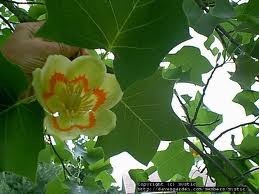Despite its name, the tulip poplar tree is a member of the magnolia family. The tulip poplar is the tallest hardwood tree in the eastern forest growing to heights of 80 to 120 feet with a diameter of 2 to 5 feet, with unconfirmed reports of tulip poplar trees reaching 200 feet. Named in part for its leaves and flowers that resemble tulips, the tulip poplar lives a long life under the right conditions.
Habitat
-
The natural habitat of the tulip poplar tree is the east and southeast of the United States extending north to Ontario, Canada and west to Texas. These trees flourish in "moderately moist, deep, well drained, loose textured soils," as written on the United States Department of Agricultural Natural Resources Conservation Service website. For this tree, moderation is key and very few survive in very wet or dry conditions. Soil needs to be within the pH range of 4.5 to 7.5. Although the tulip poplar thrives in these ideal conditions it is a very tough tree.
Favorite Places to Grow
-
 Natural Habitat in East and Southeast North America
Natural Habitat in East and Southeast North AmericaAccording to the National Register of Big Trees, the tallest living tulip poplar grows in Bedford, Virginia. It’s about 111 feet high and its trunk is more than 31 feet in circumference. The oldest living tulip poplar is about 225 years old in New York. The tulip poplar was Kentucky’s first state tree. It is known to favor eastern Kentucky’s mountains, flourishing in the moist, deep soils in mountain coves and beside streams. Since they require full sunlight to grow, seeds that blow into overgrown fields tend to find the perfect home.
Habitat Needed for Regeneration
-
 Kentucky’s First State Tree
Kentucky’s First State TreeThe tulip poplar produces a lot of seeds, on average 12,000 seeds per pound, which fall from the cone shaped fruit clusters. Despite the amount of seeds that fall, few germinate. Seeds need nutrient and mineral rich soil with moderate moisture and enough sunlight. They will not tolerate shade.
Reforestation
-
 Spreading its Seeds
Spreading its SeedsSince tulip poplar trees grow quickly they are often used in reforestation projects. These trees naturally regenerate through seed and stump sprouts. They are very tough trees and are known to live for centuries. Their wood is used for timber for furniture, pulpwood and veneer. It is rather soft and light, though brittle, making it very easy to work with. The tulip poplar are hardy in nature, grow quickly and are extraordinarily disease and insect free, making it perfect for reforestation.
Potential Challenges for the Tulip Poplar
-
Within their natural habitat, there are challenges for the tulip poplar tree. Tulip poplar trees are vulnerable to ice and wind damage when in an exposed habitat. Some of the pests that present problems for them are Nectria canker, Fusarium canker and yellow-poplar weevil. Tulip poplar trees require moist soil. In areas of drought adequate irrigation is necessary to keep this tree healthy and growing.


Deprecated: strpos(): Passing null to parameter #1 ($haystack) of type string is deprecated in /home/agriviek8Qv/agriviet.net/public_html/wp-includes/comment-template.php on line 2522